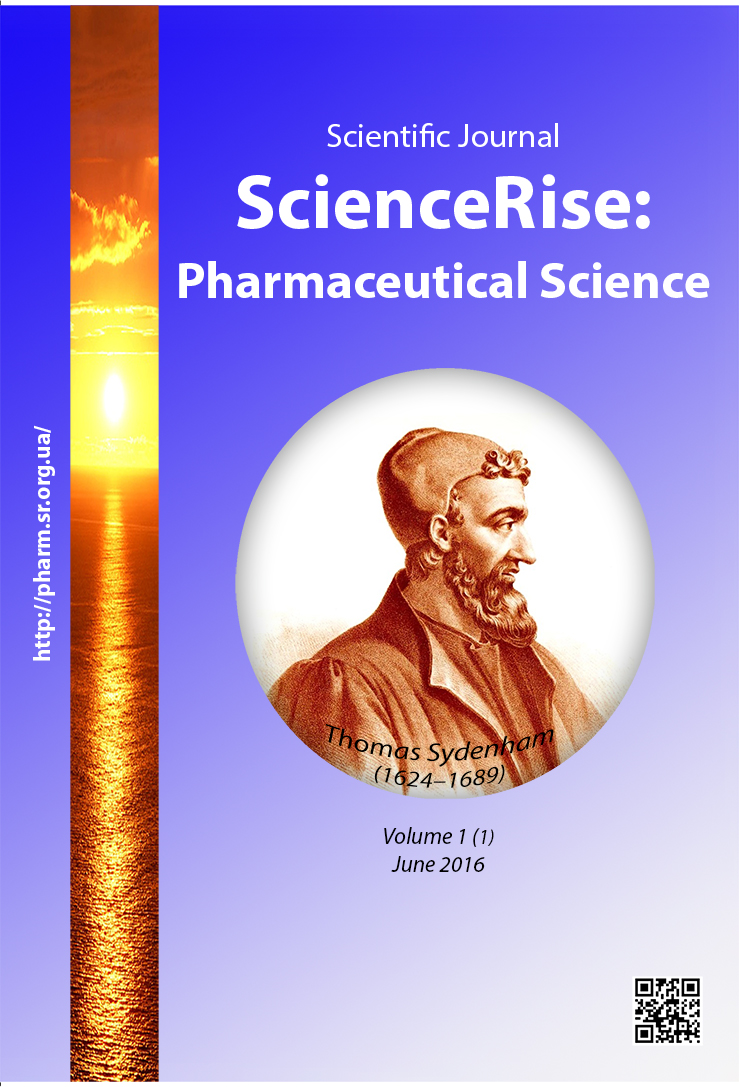The analysis of iridoid compounds in motherwort herb
DOI:
https://doi.org/10.15587/2519-4852.2016.72811Keywords:
The analysis of iridoid compounds in Motherwort herbAbstract
The pressing objective for modern pharmacy is the search of new herbal remedies with ensured resource base for successful realization of national programs, prescribed by the Concept of pharmaceutical sector development of healthcare of Ukraine for 2011–2020 years, devoted to development and implementation of efficient, safe, non-toxic, and standardized according to European standards of quality phytopharmaceutical remedies, manufactured in accordance to the modern technologies with verified effect and dosage.
Motherwort herb contains alkaloids, flavonoids (quinqueloside, rutin, quercetin, glucorhamnoside, hyperoside, etc.), triterpene saponins, steroids, tannins, essential oil, organic acids, monoterpene (iridoids) and diterpene compounds, choline, vitamins, micro- and macroelements. Such composition of biologically active compounds (BAC) causes sedative, anticonvulsant, antianginal, hypotensive, antispasmodic, and diuretic effect. Besides, motherwort herb provides soft cardiotonic effect. Glucorhamnoside of Motherwort herb slows the heart rate down, reduces blood pressure, and shows sedative action. Flavonoids, iridoids, and steroids cause antispasmodic, sedative, and hypotensive properties. Remedies, containing Motherwort, are related to drugs influencing the nervous system.
Aim. The aim of our work was identification and quantitative analysis of iridoids in Motherwort herb and in viscous extract on its basis (MHVE).
Methods. Identification of different groups of BAC was carried out using qualitative reactions and thin-layer chromatography method (TLC). Standardization was carried out by means of spectroscopy method.
Results. As a result of research, identification of iridoid components by TLC method in Motherwort herb and in MHVE was substantiated, and Motherwort herb and VEMH were standardized by iridoids content.
Conclusion. Motherwort herb is herbal source to obtain remedies influencing the nervous system. BAC complex of herb, in particular iridoids, shows sedative effect; therefore, their sequential identification and standardization in herb-remedy line is important
References
- Kovalenko, V. N. (Ed.) (2014). Kompendium 2014 – lekarstvennye preparaty. Kyiv: MORION, 1408.
- Ritter, M., Melichar, K., Strahler, S., Kuchta, K., Schulte, J., Sartiani, L. et. al. (2009). Cardiac and Electrophysiological Effects of Primary and Refined Extracts from Leonurus cardiaca L. (Ph.Eur.). Planta Medica, 76 (06), 572–582. doi: 10.1055/s-0029-1240602
- Bernatoniene, J., Kopustinskiene, D., Jakstas, V., Majiene, D., Baniene, R., Kuršvietiene, L. et. al. (2014). The Effect of Leonurus cardiaca Herb Extract and Some of its Flavonoids on Mitochondrial Oxidative Phosphorylation in the Heart. Planta Medica, 80 (07), 525–532. doi: 10.1055/s-0034-1368426
- Kobzar, A. Ja. (2007). Farmakognozija v medycyni. Kyiv: Medycyna, 544.
- Morteza-Semnani, K., Saeedi, M., Akbarzadeh, M. (2008). The Essential Oil Composition of Leonurus cardiaca L. Journal of Essential Oil Research, 20 (2), 107–109. doi: 10.1080/10412905.2008.9699966
- Wojtyniak, K., Szymański, M., Matławska, I. (2012). Leonurus cardiaca L. (Motherwort): A Review of its Phytochemistry and Pharmacology. Phytotherapy Research, 27 (8), 1115–1120. doi: 10.1002/ptr.4850
- Derzhavna farmakopeja Ukrai'ny (2008). Kharkiv: Derzh. p-vo «Naukovo-ekspertnyj farmakopejnyj centr», 620.
- Derzhavnyj rejestr likars'kyh zasobiv Ukrai'ny. Informacijnyj fond. Available at: http://www.drlz.com.ua/
- European Pharmacopoeia (2011). Strasbourg: European Department for the Quality of Medicines, 1324–1325.
- Aleksandrova, A. E., Arzamascev, A. P., Bagirova, V. L. et. al. (2001). Nastojki, jekstrakty, jeliksiry i ih standartizacija. Sankt-Peterburg: Spec. Lit, 223.
- Gryzodub, O. I., Jevtifjejeva, O. A., Proskurina, K. I. (2012). Osoblyvosti farmakopejnyh pidhodiv shhodo kil'kisnogo vyznachennja likars'koi' roslynnoi' syrovyny ta sumarnyh fitopreparativ. Farmakom, 3, 7–31.
- Curkan, O. O., Nizhenkovs'ka, I. V., Jushhyshena, O. V. et. al. (2014). Doslidzhennja irydoi'div Vitex agnus-castus L. ta V. cannabifolia Sieb. Farmacevtychnyj zhurnal, 2, 101–104.
- Ivanova, L. R., Butenko, L. I., Ligaj, L. V. (2010). Opredelenie iridoidov v trave tatarnika koljuchego (Onopordum acanthium L., rod Onopordum). Himija rastitel'nogo syr'ja, 4, 131–133.
- Danylov, S. A., Shtrygol', S. Ju., Tovchyga, O. V., Stepanova, S. I., Dmytrijevs'kyj, D. I., Komisarenko, A. M. (2011). Svitova flora sedatyvnyh likars'kyh roslyn, suchasnyj asortyment i'h preparativ v Ukrai'ni ta docil'nist' stvorennja novyh zasobiv. Farmakologija ta likars'ka toksykologija, 5, 88–89.
- Popescu, M. L., Dinu, М., Toth, О. (2009). Contributions to the pharmacognostical and phytobiological study on Leonurus cardiaca L. (Lamiaceae). Farmacia, 57 (4), 424–431.
Downloads
Published
How to Cite
Issue
Section
License
Copyright (c) 2016 Павло Сергійович Омельченко, Євген Володимирович Гладух, Ірина Сергіївна Бурлака

This work is licensed under a Creative Commons Attribution 4.0 International License.
Our journal abides by the Creative Commons CC BY copyright rights and permissions for open access journals.








